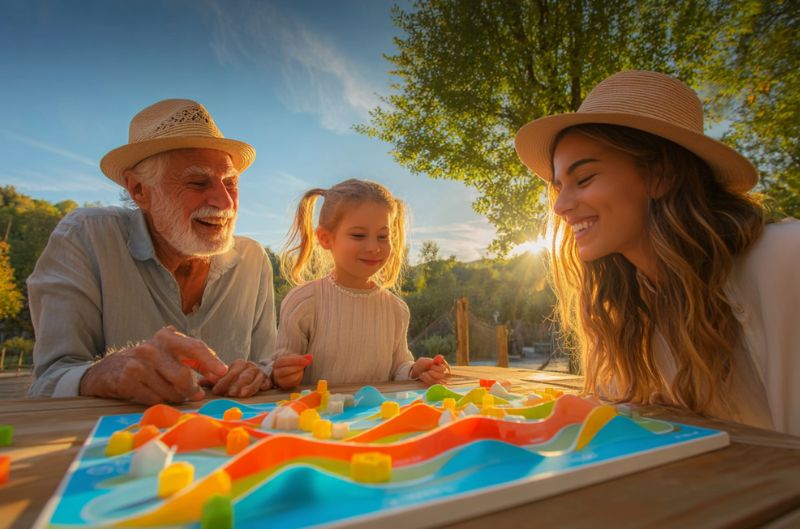
The Role of Play in Building Intergenerational Bonds
Author: Austin Stanfel
Play is a universal language, transcending age, culture, and background. Playing together offers a powerful connection in an era where generations are often separated by technology, lifestyle, and geography. Intergenerational play—activities shared by children, parents, and grandparents—creates joyful memories, strengthens family ties, fosters community, and supports the well-being of all involved.
The Power of Shared Play
Intergenerational play is about more than just fun. It is a dynamic process that transforms ordinary spaces, like parks, playgrounds, and living rooms, into vibrant environments where people of all ages can connect and learn from one another. When children and adults play together, they break down social barriers and build mutual understanding. Play becomes a bridge between generations, offering opportunities for shared experiences that are rare in daily life.
Strengthening Family and Community Bonds
One of the most profound benefits of intergenerational play is its ability to strengthen family bonds. When children, parents, and grandparents play together, they create shared memories and deepen emotional connections. These experiences reduce feelings of isolation among older adults and enhance a sense of belonging for children and adolescents. Families, playgroups, and multigenerational playgrounds become spaces where everyone is valued and included, fostering a sense of community and continuity.
Community benefits are equally significant. Shared play spaces encourage regular interaction among neighbors of all ages, building stronger, more resilient communities. The sense of belonging from these interactions can combat loneliness and isolation, common challenges for new parents and seniors.
Physical and Mental Health Benefits
Play is essential for maintaining physical health at every stage of life. For children, active play supports the development of motor skills and overall fitness. For older adults, staying active through play can prevent chronic illnesses, improve mobility, and even reduce the risk of cognitive decline. Intergenerational playgrounds and playgroups often incorporate walking paths, exercise stations, and interactive play structures, making physical activity accessible and enjoyable for everyone.
The mental health benefits are equally compelling. Playing naturally relieves stress and improves mood. It offers children a break from academic pressures; for adults, it provides a respite from daily stressors. Engaging in playful activities together can reduce anxiety and depression, fostering joy and laughter across generations. Research also shows that children who play with adults demonstrate greater creativity, improved language skills, and enhanced problem-solving abilities.
Cognitive and Emotional Growth
Intergenerational play stimulates cognitive development in both children and adults. Activities such as puzzles, memory games, and strategic play challenge the mind and promote mental agility. Storytelling, arts and crafts, and digital games provide additional avenues for creative expression and shared learning. These activities enhance cognitive abilities and help children and adults express emotions, develop empathy, and build self-esteem.
Older adults who play with children often experience positive mood changes and higher levels of engagement, even among those who are frail or isolated. Play provides opportunities for older adults to share their knowledge and wisdom, while children benefit from the guidance and attention of experienced elders.
Breaking Down Barriers and Fostering Empathy
Intergenerational play is a powerful tool for breaking social barriers and fostering empathy. When people of different ages play together, they develop awareness, understanding, and respect for each other’s perspectives. Playgroups and community-based activities create safe spaces where new friendships can form and everyone can feel valued and included regardless of age.
Interacting with older adults helps children develop social and language skills, empathy, gentleness, and respect for others. For older adults, play provides a sense of purpose and self-worth, reduces feelings of isolation, and encourages them to stay active and engaged in their communities.
Types of Intergenerational Play
Intergenerational play can take many forms, from traditional outdoor games like tag and hide-and-seek to indoor activities such as board games, puzzles, and arts and crafts. Digital games and interactive apps designed for multiple players are also becoming popular, offering new ways for tech-savvy children and older adults to connect. Storytelling and reading aloud allow sharing of personal histories and cultural heritage, further strengthening intergenerational bonds.
Playgroups can be organized in various settings, including residential aged care facilities, community halls, schools, and parks. These groups offer structured and spontaneous opportunities for people of all ages to come together, learn from one another, and build lasting relationships.
The Lasting Impact of Play
The impact of intergenerational play extends far beyond the moment. The memories created through shared play become cherished family stories passed down through generations. The skills and values learned—such as cooperation, patience, and empathy—stay with participants throughout their lives. As the saying goes, “We do not stop playing because we grow old; we grow old because we stop playing.”
Intergenerational play is not just about having fun; it is about building connections, promoting health, and enhancing the well-being of entire communities. By embracing the power of play, we can create inclusive, vibrant environments where people of all ages can thrive together.

